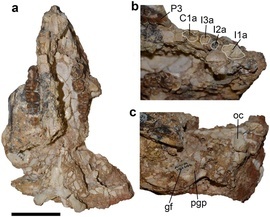Mukupirna nambensis: A new species of Vombatiform Marsupial from the Oligocene of South Australia.
[sciencythoughts.blogspot.com]
The three living species of wombat (Vombatus ursinus, Lasiorhinus latifrons and Lasiorhinus krefftii; family Vombatidae) and the koala (Phascolarctos cinereus; family Phascolarctidae) are among the most iconic and unusual of Australia’s Marsupials. They are the only survivors of the clade Vombatiformes, one of the two major subclades within the order Diprotodontia; the other, Phalangerida, includes Possums, Kangaroos, Wallabies and Rat Kangaroos. Fossil Vombatiforms were highly diverse and included the large-bodied, herbivorous Diprotodontids, the possibly Tapir- or Chalicothere-like Palorchestids, and the carnivorous Thylacoleonid 'Marsupial Lions'. Vombatiformes suffered extensive extinctions during the Pleistocene; the last surviving members of several families (Diprotodontidae, Palorchestidae and Thylacoleonidae) went extinct, as did several Vombatid and Phascolarctid species, leaving the modern Wombats and Koala as the only remnants of this former diversity.



Enjoy being online again!
Welcome to the community of good people who base their values on evidence and appreciate civil discourse - the social network you will enjoy.Create your free account
2 comments
Feel free to reply to any comment by clicking the "Reply" button.Recent Visitors 14
Ritchie
PA, USA
EyesThatSmile
Gulf Coast Of Texas,
Hathacat
IL, USA
tinkercreek
Portland Burb,
Triphid
Broken Hill,
Photos 292 More
Posted by JoeBKite-like structures in the western Sahara Desert.
Posted by TriphidAn Aussie Indigenous Message Stick.
Posted by TriphidIndigenous Australian Aboriginal Rock art dated somewhere between 20 and 30 thousand years old.
Posted by TriphidIndigenous Australian Aboriginal Rock art dated somewhere between 20 and 30 thousand years old.
Posted by TriphidIndigenous Australian Aboriginal Rock art dated somewhere between 20 and 30 thousand years old.
Posted by TriphidIndigenous Australian Aboriginal Rock art dated somewhere between 20 and 30 thousand years old.
Posted by JoeBDortoka vremiri: A new species of Dortokid Turtle from the Late Cretaceous of the Hațeg Basin, Romania.
Posted by JoeBThe Cabeço da Amoreira burial: An Early Modern Era West African buried in a Mesolithic shell midden in Portugal.
Posted by JoeBMusivavis amabilis: A new species of Enantiornithine Bird from the Early Cretaceous Jehol Biota of northeastern China.
Posted by JoeBTorosaurus in Canada.
Posted by JoeBStone tools from the Borselan Rock Shelter, in the Binalud Mountains of northeastern Iran.
Posted by JoeBDating the Lantian Biota.
Posted by JoeBBashanosaurus primitivus: A new species of Stegosaur from the Middle Jurassic of Chongqing Municipality, China.
Posted by JoeBDetermining the time of year when the Chicxulub Impactor fell.
Posted by JoeBSão Tomé and Príncipe: Possibly the last country on Earth never to have been visited by a working archaeologist.
Posted by JoeBMambawakale ruhuhu: A new species of Pseudosuchian Archosaur from the Middle Triassic Manda Beds of Tanzania.





